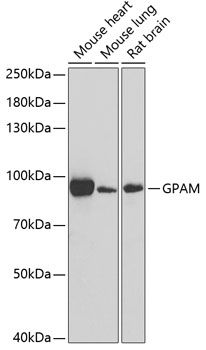Product Name :
GPAM polyclonal antibody Background :
GPAM (glycerol-3-phosphate acyltransferase, mitochondrial), also known as GPAT1, GPAT or KIAA1560, is an 828 amino acid multi-pass membrane protein that localizes to the outer membrane of the mitochondria and is involved in phospholipid metabolism. More specifically, GPAM functions to catalyze the first and committing step in the biosynthesis of glycerolipid, namely the conversion of Acyl-CoA and sn-glycerol 3-phosphate to CoA and 1-acyl-sn-glycerol 3-phosphate. Via its catalytic activity, GPAM plays an essential role in the regulation of cellular triacylglycerol and phospholipid levels. The gene encoding GPAM maps to human chromosome 10, which houses over 1,200 genes and comprises nearly 4.5% of the human genome. Defects in some of the genes that map to chromosome 10 are associated with Charcot-Marie Tooth disease, Jackson-Weiss syndrome, Usher syndrome, nonsyndromatic deafness, Wolman’s syndrome, Cowden syndrome, multiple endocrine neoplasia type 2 and porphyria. Product :
Rabbit IgG, 1mg/ml in PBS with 0.02% sodium azide, 50% glycerol, pH7.2 Storage&Stability :
Store at 4°C short term. Aliquot and store at -20°C long term. Avoid freeze-thaw cycles. Specificity :
GPAM polyclonal antibody detects endogenous levels of GPAM protein. Immunogen :
Recombinant full length Human GPAM. Conjugate :
Unconjugated Modification :
Unmodification
GPAM polyclonal antibody Background :
GPAM (glycerol-3-phosphate acyltransferase, mitochondrial), also known as GPAT1, GPAT or KIAA1560, is an 828 amino acid multi-pass membrane protein that localizes to the outer membrane of the mitochondria and is involved in phospholipid metabolism. More specifically, GPAM functions to catalyze the first and committing step in the biosynthesis of glycerolipid, namely the conversion of Acyl-CoA and sn-glycerol 3-phosphate to CoA and 1-acyl-sn-glycerol 3-phosphate. Via its catalytic activity, GPAM plays an essential role in the regulation of cellular triacylglycerol and phospholipid levels. The gene encoding GPAM maps to human chromosome 10, which houses over 1,200 genes and comprises nearly 4.5% of the human genome. Defects in some of the genes that map to chromosome 10 are associated with Charcot-Marie Tooth disease, Jackson-Weiss syndrome, Usher syndrome, nonsyndromatic deafness, Wolman’s syndrome, Cowden syndrome, multiple endocrine neoplasia type 2 and porphyria. Product :
Rabbit IgG, 1mg/ml in PBS with 0.02% sodium azide, 50% glycerol, pH7.2 Storage&Stability :
Store at 4°C short term. Aliquot and store at -20°C long term. Avoid freeze-thaw cycles. Specificity :
GPAM polyclonal antibody detects endogenous levels of GPAM protein. Immunogen :
Recombinant full length Human GPAM. Conjugate :
Unconjugated Modification :
Unmodification
-
 WesternBlot (WB) analysis of GPAM polyclonal antibody
WesternBlot (WB) analysis of GPAM polyclonal antibody
Bioworld Biotech only provide peptides for our antibodies and do not provide additional peptide customization services.
Price/Size :
USD 368/1mg/vial
Tips:
For phospho antibody, we provide phospho peptide(0.5mg) and non-phospho peptide(0.5mg).Describe :
Blocking peptides are peptides that bind specifically to the target antibody and block antibody binding. These peptide usually contains the epitope recognized by the antibody. Antibodies bound to the blocking peptide no longer bind to the epitope on the target protein. This mechanism is useful when non-specific binding is an issue, for example, in Western blotting (WB) and Immunohistochemistry (IHC). By comparing the staining from the blocked antibody versus the antibody alone, one can see which staining is specific; Specific binding will be absent from the western blot or IHC performed with the neutralized antibody.Formula:
Synthetic peptide was lyophilized with 100% acetonitrile and is supplied as a powder. Reconstitute with 0.1 ml DI water for a final concentration of 10 mg/ml.The purity is >90%,tested by HPLC and MS.
Storage:
The freeze-dried powder is more stable. For short time at 2-8°C. For long term storage store at -20°C.
Note :
This product is for research use only (RUO only). Not for use in diagnostic or therapeutic procedures.
 GPAM polyclonal antibody
GPAM polyclonal antibody  Datasheet
Datasheet COA
COA MSDS
MSDS SHIP
SHIP